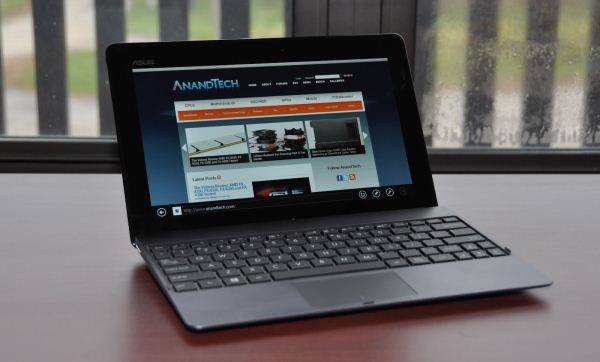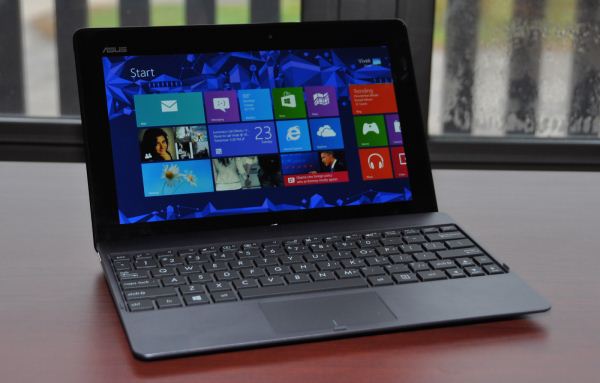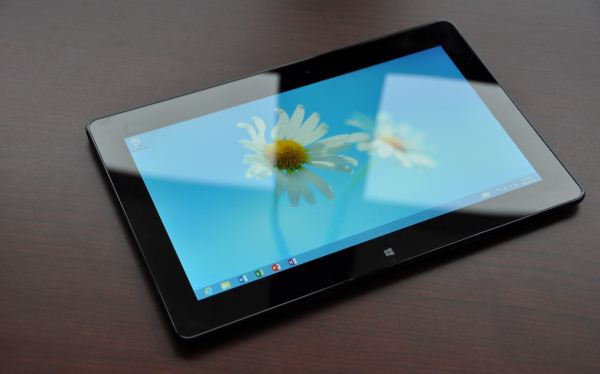ASUS VivoTab RT Review
by Vivek Gowri on October 23, 2012 3:01 PM EST- Posted in
- Asus
- Mobile
- Tablets
- Windows RT
- Vivo Tab
Windows RT is Microsoft’s big play for the tablet market. Our full Windows RT review will be posted later tonight, so for now I’m just going to share my personal impressions of the operating system from my time with the VivoTab RT.
This is a story that begins with Apple, who have spent a lot of time in the last two years talking about the “post-PC era”. Unfortunately, their product lines continue to be distinctly divided between mobile devices and personal computers. Going forward, that might change, but for now there’s just a significant gap between the iPad and the 11” MacBook Air. Microsoft has avoided that issue entirely by making the OS division happen between handhelds (phones) and portables (tablets and notebooks), instead of between tablets and notebooks. Given the similarity in size and usage between 10” tablets and the smallest notebooks, this makes a ton of sense to me. In Microsoft’s version, the post-PC world isn’t actually post-PC at all, it just involves the next evolution of the PC. Count me as a fan.
The VivoTab RT serves almost all of my purposes as a notebook replacement in ways I’ve spent 2.5 years wishing my iPad would. I’ve had all three iPads, all launch-day purchases. The first lasted exactly ten days before I returned it for general uselessness. I kept my iPad 2 for nine months, but spent about seven of them not using it at all. My 2012 iPad though has actually been a pretty valuable mobile companion to me - the screen is finally sharp enough for me to use it as an ebook reader, and as the device has gotten more powerful, it’s gotten easier to do a lot of my browsing and quick messaging/email/text editing on it. I’ve supplemented it at various times with different Bluetooth mobile keyboards (including Microsoft’s new W8-centric Wedge Mobile Keyboard), and turned it into a semi-credible facsimile of a notebook PC. But it never came together properly for me - it’s still too difficult to get real work done on an iPad. Not quite impossible anymore, but still not easy, or as easy as it should be.
Windows RT (and Windows 8) changes that for me. The tablet-centric Metro design language (now officially referred to as “Modern UI”, but it will always remain Metro in my heart) is obviously designed around the touchscreen input, and it’s entirely possible to avoid desktop mode if you want to, so it really works seamlessly as a tablet. This is the best task switching implementation I’ve seen yet for modern tablets, as well as the most thorough use of gestures. A few of them are a little intricate at first, like tile reorganization, but quickly become second nature. We’ve long been fans of the Windows Phone 7 user interface, regardless of the platforms other flaws, and seeing it expanded to tablets is great.
Windows RT and Windows 8 look and feel exactly the same. There are three major differences that are worth talking about. The first is Office 2013 being included for free - I frequently take this for granted, because I’ve always gotten Office free from school, work, or friendship with a large number of Microsoft employees (a hazard of being an Indian living in the Seattle area) - but if you don’t get Office for free, it’s a nice throw-in that certainly adds to some of the cost of the platform. And when you think about it, $499 for a Windows RT tablet with 32GB of NAND and Office 2013 included free out of the box is actually a pretty good deal compared to the $499 16GB iPad.
The others are x86-related - you obviously give up a ton amount of compute horsepower versus any of the Core-based processor, but even compared to Clover Trail, Tegra 3 is not that fast. Well matched to the platform though, and other than some issues with application load times (becoming a common theme with Microsoft OSes, it appears) you rarely feel the lack of speed when you stay in Metro/Modern UI. Entering Windows Desktop mode brings up some noticeable lag though, particularly in closing IE (desktop) tabs and other windows. Sure, I’m used to i7/SSD machines in my daily life, but these are the kinds of lags that you rarely find on, say, ultrabooks. And when you look at CPU utilization, you’re in for a bit of a shocker. Using the keyboard dock, you can get to 30% CPU load in Word 2013 when just typing (like a madman, sure, but still). Switch to the virtual keyboard and press buttons at random? You can get to 50% load, easy. When typing normally, you can get to 25-30% without trying too hard. With any A9-based SoC, you can’t expect the greatest performance, but it does give me a lot of hope for the Krait and Clover Trail-based tablets set to come out, not to mention A15 next year.
The single biggest difference though, is the lack of x86 app compatibility. This seems like an obvious difference at first - duh, it’s ARM, of course x86 applications don’t work - but it’s something that you can almost forget as you start using Windows desktop mode. For applications, you’re limited to the Windows Store, which serves up apps that are built to run within Modern UI and are designed around the Metro aesthetic. The selection at the moment is a little bit lacking, but we’re still three days from the official launch of Windows 8/RT, so I’m not going to judge it yet. This is Windows we’re talking about, so I’m not terribly worried about the development of the app library - it’ll happen soon, or Microsoft will pay developers to make it happen soon. Either way, we should see a much healthier selection of apps in the near future.
One side effect of this is that, unless I’m writing, I don’t enjoy using the keyboard dock very much - mouse inputs just aren’t as convenient as touching the screen and getting to where you want, particularly since certain mouse gestures within Modern UI just aren’t that intuitive. It’s a brilliant touch UI, just not a brilliant desktop one. (Side note: in Windows 8, particularly for normal notebook and desktop users, this is an entirely overblown issue - you can basically treat Modern UI as a fancy Start menu, and spend the rest of your life in Windows desktop. It works exactly the same way - hit the Windows key, start typing to search through applications, and if you do it right, that can be the vast majority of your interaction with the Metro-side of things. Yes, I agree that Metro is far and away not a great UI to navigate with a mouse, but people who claim that Windows 8 will ruin their desktops just sound uninformed. But I digress.)
I’ve still kept the VivoTab RT docked for a majority of the time though, for two reasons. One - after a year and a half with the iPad Smart Cover, I’ve gotten used to having a way to stand my tablet up (I love that Surface has this built in.) The other is the battery life thing, which I’ll get to in a bit, but having a combined total of 47Wh of battery capacity in a Windows system is just awesome.
And that’s what’s important to remember with Windows RT - beneath Modern UI, it’s still just Windows. Same file structure, same control panel, same task manager. If you don’t want to use it, you almost never have to see it - there’s very few workflows that require desktop mode to be used (Office 2013, which runs in the desktop, can be fullscreened to block the rest of Windows out). But if you want the control and power that you typically get in a normal PC, it’s all still here for you. It’s incredibly reassuring - this works just like every computer I’ve owned since my first Gateway 2000 back in 1996, at the tender age of 5. It’s just Windows, except with a touch-screen UI on top of it.
I’m coming away from this review feeling very positive about Windows RT, much more so than I expected. After a few days with it, I’m officially done with my iPad. Like, that’s it, we had a good run, it’s over. (In related news, if anyone wants a pristine condition 3rd generation iPad, my email address is linked to the byline. I’m only halfway joking.) Windows RT hits the convergence for me better than any previous tablet and integrates into my workflow almost seamlessly, making it the first tablet platform that seriously has a shot at replacing my notebook.














68 Comments
View All Comments
frostyfiredude - Tuesday, October 23, 2012 - link
Surface RT has a 10% larger display, but a 30% larger battery. Processor power usage should remain constant even with the larger display, so the power usage won't actually go up 10%, but somewhere lower like 7 or 8%.Considering those two, wouldn't it make sense that Surface RT actually gets greater battery life than an un-docked VivoTab RT? Supposedly Surface engineers are hitting 12 hours of usage with it, which seems about right to me at 18-33% greater life than the Vivo RT here.
ssiu - Tuesday, October 23, 2012 - link
"but even compared to Clover Trail, Tegra 3 is not that fast""But given how well RT runs on quad-core Cortex A9, I’m just eager to see shipping devices with faster SoCs - Krait and Clover Trail in the coming weeks, A15 in the not-too distant future. "
I already think "Atom == slow" (poor experience with early netbook). If Windows RT tablets are slower than Windows 8 Atom tablets than I don't know why anyone would choose the former. Even if Krait or A15 is a bit faster than Clover Trail, personally I'd still choose x86 compatibility.
Urizane - Tuesday, October 23, 2012 - link
Early netbook slowness depends on more than just the CPU. A large majority of early netbooks had very little RAM as well as slow hard drives. These days, there's a lot more RAM as well as solid state storage. I remember old Atom 330 machines that you could upgrade from 1 GB of RAM to 2 GB that made a pretty sizeable difference in day-to-day use. Upgrading to an SSD makes application load times even better. The CPU wasn't fast, but it also wasn't the only reason people hated early netbooks.Impulses - Friday, October 26, 2012 - link
More RAM and a SSD worked wonders even for first gen Atom netbooks (single core)... For a tablet workflow it's not really any worse than current ARM SoC, now if you're trying to use it as a laptop replacement that's another story. I think that term is gonna get thrown around too easily with these hybrid Win RT devices...Even looking past the dire lack of apps (beyond Office), raw performance isn't where it needs to be to make such a concept reality, performance's obviously not gonna be there until A15/S4 Pro/next gen Atom. Laptop alternative might be the more accurate term, tho it's all obviously very dependent on your particular needs.
powerarmour - Thursday, October 25, 2012 - link
You need to bear in mind the graphics capabilities of Tegra 3 vs Clover Trail, Clover Trail is looking like it's going to be a mess on those regards, with Intel yet again failing to deliver a PowerVR driver of any decent quality.What good is a slightly better CPU, when the only thing 3D it can run is the Metro desktop?
Relic74 - Tuesday, January 1, 2013 - link
I just bought the Asus 810c Vivo, though I to have had bad experience with a Atom CPU netbook from Nokia I am quite impressed as to how snappy the OS is. I'm a programmer so the only desktop apps I really use are Netbeans, Java SDK, FileZilla, Bittorent, OpenOffice, Gimp, Inkscape, Thunderbird, Firefox, XAMPP and Google Earth. All run extremely well but I can't express to you guys enough how fast Windows 8 fly's on this system and that battery, wow, 17.5 hours. I literary charge it ounce every 4 days. As a road machine it's bar none one of the best laptops I have ever owned. I'm digging the Vivo a lot and I'm starting to appreciate Microsoft tablet vision.I see how a lot of you get caught up in benchmarks but when you travel as much as I do it's all about longevity, my other laptop is a Lenovo X220T and even with a batter slice I still barely get about 7 hours.
Flunk - Tuesday, October 23, 2012 - link
This review is great and it's good to see ARM powered Windows in a real device... But I (and I'm sure other readers) would love to see a review of the newly announced Asus Zenbook U500VZ. It sounds like a really interesting device, and touch sounds a little strange on a 15" device.Just hoping you guys do a review, you guys are one of the most reputable sources for reviews.
dananski - Tuesday, October 23, 2012 - link
30% CPU usage from typing in Word 2013 doesn't surprise me - I've had 2013 on my new i7 desktop for a while and I sometimes get lags while typing in Word or clicking around in Excel. Don't try to move the windows around the screen - some very dodgy performance issues there; I used the feedback button to highlight a few.I wonder if these performance issues will make it into the release version. Back when I got Office 2007 there were a few times when performance went terrible in Excel, which they fixed in SP1. Here's hoping that's not going to be the case again...
cmdrdredd - Tuesday, October 23, 2012 - link
Might compete well with a Transformer Infinity in benchmarks but it needs apps.B3an - Tuesday, October 23, 2012 - link
Nice review. And i agree with everything said in it. This looks like a good device and i'd easily choose it over an iPad or Android tablet, but i'll likely go with a Win 8/x86 tablet.